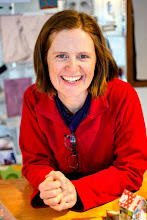Here is the self-portrait I saw in Amsterdam, entitled Self-Portrait As Apostle Paul, painted in 1661 (or you can click here to see a sampling of his other self-portraits):
The Rijksmuseum has a large collection of other famous works by this artist. Before I went there, I never really felt that connected to Rembrandt. I understood that he did things that were special and important in terms of art-making, but he was just one of many. But now that I've seen so many works of his, and visited his house, now a museum, I am newly in awe.
The three Rembrandt paintings I spent the most time with in the Rijksmuseum were:
The Jewish Bride, ca. 1667
The Syndics of the Amsterdam Drapers' Guild, known as the ‘Sampling Officials,’ 1662
The Night Watch, 1664
Rather than go on an on about my personal experience with these paintings, I want to tell you that the Rijksmuseum experience was really great. Technology is being utilized to make museum visits all the better. The audio guide or (free) app that accompanies these paintings and many more of the works in the museum is what made my time with them so rich and meaningful. You've probably heard this before, not only from me about my own work, but from others: seeing an artwork in person is no comparison to the pictures of it, whether in books or online. Like I said, it is the experience of seeing these pieces in person that makes me feel like I have a relationship with them. I understand them and the artist so much better now.
At the risk of writing a (too?) lengthy post, let me tell you about a few more things, Rembrandt-related.
After seeing these paintings, I visited Rembrandthuis, where Rembrandt lived in Amsterdam during the height of his career as a sought-after artist.
The house was completed devoted to art. Sure, there was a kitchen and a place for him to sleep, but otherwise, here were the rooms:
- an entry room and a separate gallery for his patrons and buyers to come view/buy art
- a small office in order to keep his papers in order
- a beautiful, large, north-facing studio
- a room of curiosities where he kept things like busts or statues of feet or hands, or stuffed alligators or skeletons of fish or coins or feathers or costumes or armor
- a separate studio where he taught his students, and
- a room for etching or print-making
During my visit, I got to see a demonstration on etching/print-making, and another about how he would have made paint. (Rembrandt achieved all he did with just 13 paint colors!)
Finally, as I stepped onto the top floor, where the teaching studio was, a woman invited me to participate in a free art workshop in which we would study light and dark. I didn't hesitate! For the next hour and a half, I and 6 other "students" used one of three mediums (graphite, a red drawing medium similar to conti, and something completely new to me, bistre) to copy the forms and shapes of an upside down image she provided. She encouraged me to try the new medium, which I thought would be a great challenge.
At some point, the profound fact occurred to me that I was spending time in the studio of a great 17th century artist, painting, doing an exercise he himself might have had his students do. Was this real?
Then, the reveal! Flip them over and all of a sudden, there's a scene! All of ours were laid out, and the teacher talked us through what we had learned.
I got so much more than I'd bargained for at the Rembrandthuis. Thanks to that, to the museum, and to these two videos, I now feel a strong connection to Rembrandt van Rijn.
1. Flash Mob acts out Rembrandt's The Night Watch in a mall (1½ minutes)



















No comments:
Post a Comment